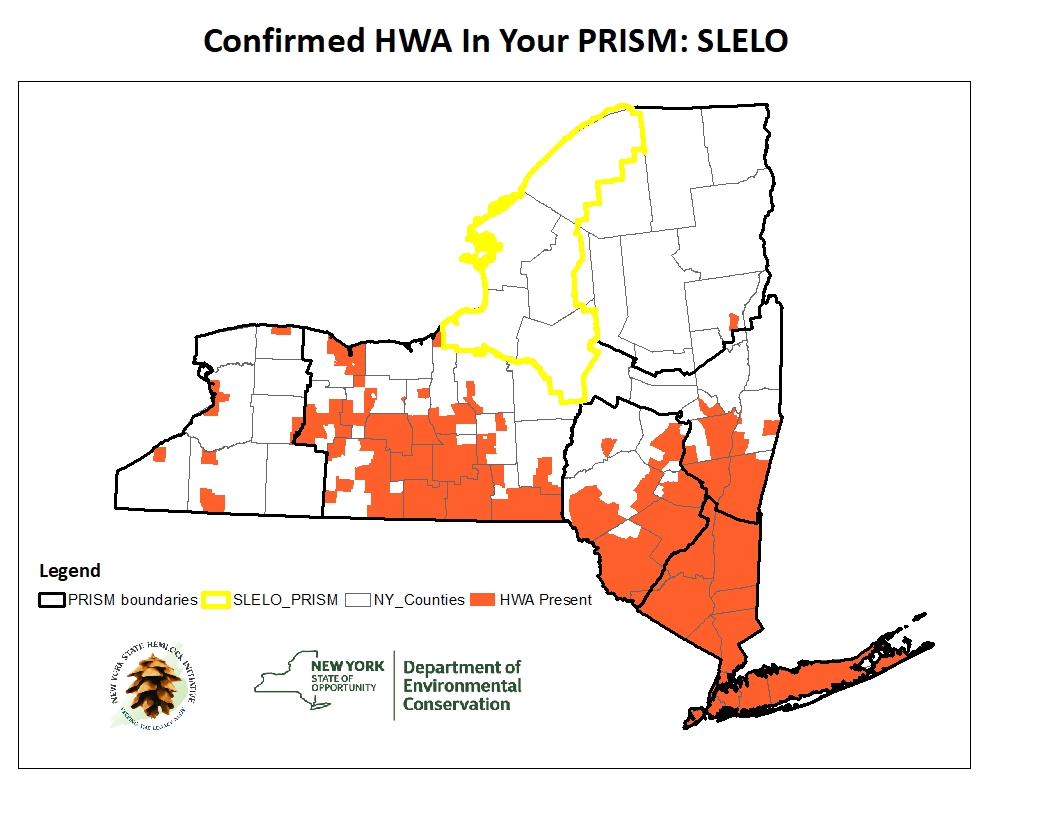Know Your PRISM
PRISM stands for Partnership for Regional Invasive Species Management. Throughout New York there are eight regional PRISMs, each representing the combined efforts of environmental and conservation organizations to make an impact across the state with a focus on invasive species surveillance and management strategies. Each PRISM in New York is taking action to help stop the spread of hemlock woolly adelgid (HWA) according to the level of infestation in each region.

Regional HWA Management
Though the New York State Hemlock Initiative is active statewide, each PRISM operates on a regional basis and has its own goals in detecting, managing, and controlling the spread of HWA. Knowing what to look for and what the priorities of your PRISM region allow us prioritize hemlock conservation in the forest and watershed ecosystems throughout New York according to their geography and level of infestation.
HWA in New York’s PRISMs

Adirondack Park Invasive Plant Program (APIPP)
The first HWA infestation in the Adirondacks was found in 2017 near Lake George.
APIPP is currently focused on surveillance, early detection, and rapid response to new HWA infestations. If you see HWA in the Adirondack region, please report your findings.
Regional Guide: APIPP
Website: adkinvasives.com

Capital Mohawk (Cap-Mo)
HWA has spread partway through the Cap-Mo PRISM region. In the southern portion of the PRISM, HWA is well-established, but the northern portion is largely uninfested and is the last line of defense between the heavily-infested Lower Hudson-Catskill region and the Adirondacks, where the majority of New York’s hemlock resources are located.
Regional Guide: Cap-Mo
Website: capitalmohawkprism.org

Catskill Regional Invasive Species Partnership (CRISP)
The Catskills are home to large numbers of New York’s hemlocks and HWA has been active in the area for over a decade. The Catskills infestation started in the southeast and has been moving roughly northwest from there. CRISP is currently focused on continued reporting, HWA management, and monitoring tree health in infested areas.
Regional Guide: CRISP
Website: catskillinvasives.com

Finger Lakes (FL-PRISM)
HWA infestations in the Finger Lakes region were first discovered in 2008. While infestations were first confined to the southern portions of Seneca and Cayuga Lakes, HWA has spread north to Skaneateles Lake and south towards Binghamton and Allegany State Park. As new infestations continue to arise, FL-PRISM is currently focused on reporting and management.
Regional Guide: FL-PRISM
Website: fingerlakesinvasives.org

Long Island Invasive Species Management Area (LIISMA)
HWA has been present on Long Island since the 1990’s and many of the region’s hemlocks are already gone. LIISMA is focused on preserving genetic diversity of hemlock trees in the region. In this region it is important to report the locations of healthy hemlocks that may be exhibiting natural resistance to infestation.
Regional Guide: LIISMA
Website: liisma.org

Lower Hudson (LH-PRISM)
HWA has been present in the Lower Hudson region since the 1990’s and many of the region’s hemlocks are already gone. LH-PRISM is currently focused on treatment and preservation of remaining stands. Landowners with infested hemlocks are encouraged to monitor the health of their trees and consider management options.
Regional Guide: LH-PRISM
Website: lhprism.org

St. Lawrence-Eastern Lake Ontario (SLELO PRISM)
The SLELO region encompasses a range of habitats that rely on hemlocks, including the dense stands in the Tug Hill region so there is a high risk from the threat of HWA. Since HWA has not been detected in the area, SLELO is currently focused on early detection of and rapid response to HWA infestations.
Regional Guide: SLELO
Website: sleloinvasives.org

Western New York (WNY-PRISM)
The first HWA infestations in the WNY PRISM region were found in 1998. Today, HWA is found only in a few towns in the region. New infestations often turn up near established HWA populations or can be spread through movement of birds, animals, or humans. Due to the limited scope of HWA in the region, WNY PRISM is currently focused on early detection efforts.
Regional Guide: WNY-PRISM
Website: wnyprism.org

Cornell Cooperative Extension
The Cornell Cooperative Extension (CCE) is another resource that helps fight the spread of hemlock woolly adelgid in New York. Through education, outreach, and volunteering efforts, CCE is working with us to broaden our reach in the state. Some of the CCE initiatives include the Master Naturalist program and the Master Forest Owner program, both of which are dedicated to learning about and managing healthier natural ecosystems and being stewards of the land.
Your local CCE office can be an invaluable tool if you are interested in conserving hemlocks in New York State. For landowners, CCE’s will often have contact information for certified applicators and arborists that can be consulted for HWA treatments. Additionally, CCE offices often have local events and resources for learning about and managing your woodlot.
CCE Offices in each PRISM
APIPP: Clinton | Essex | Franklin | Hamilton | Herkimer | St. Lawrence | Warren
Capital-Mohawk: Albany | Columbia & Greene | Fulton & Montgomery | Herkimer | Rensselaer | Saratoga | Schenectady | Washington
CRISP: Columbia & Greene | Delaware | Schoharie & Otsego | Sullivan | Ulster
Finger Lakes: Broome | Cayuga | Chemung | Chenango | Cortland | Livingston | Madison | Monroe | Onandaga | Ontario | Schuyler | Seneca | Steuben | Tioga | Tompkins | Wayne | Yates
Lower Hudson: Dutchess | New York City | Orange | Putnam | Rockland | Ulster | Westchester
SLELO: Jefferson | Lewis | Oneida | Oswego | St. Lawrence
Western NY: Allegany | Cattaraugus | Chautauqua | Erie | Genesee | Niagara | Orleans | Wyoming
